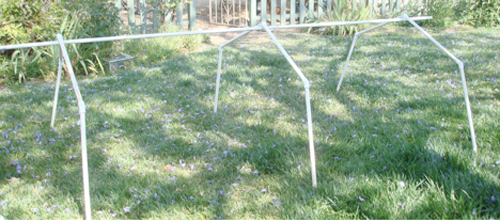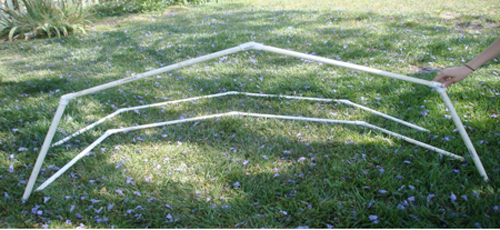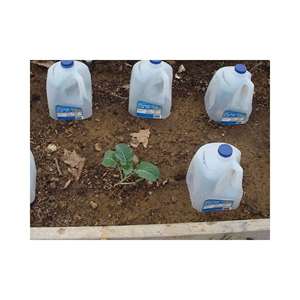Posts Tagged ‘Mini Greenhouse’
Build a Mini PVC Pipe Garden House
For many years I had trouble with birds (and my own chickens) getting into the garden and eating tender vegetable plants as they emerged from the soil. And, in the colder months I wanted to extend the growing season and protect my crops from frost. I wanted to install a hoop house, the kind I’d seen in magazines or while driving back country roads, but they were too large for one person to manage and too expensive for my limited budget.
I wanted something lightweight, easy to move and something I could make myself with supplies I might already have on hand.
I looked around the farm to see what I could use and hoped that an idea would come to mind. Sure enough, it did. As I stared at my raised beds I thought of a mini greenhouse type structure that could be draped with bird netting in the growing season and float cloth or plastic to extend my plantings.
Here’s what I came up with:

A PVC frame that fits over my 4’x8’ raised beds and is held in place by “C” brackets screwed to the wooden vegetable bed frame. A 10’ piece of PVC runs the length of the uprights to keep the covering draped properly over the frame. At ground level it can be tacked to the wooden vegetable bed or covered with dirt or rocks to keep it from blowing off.
How I made it:

I cut 4 pieces of PVC pipe 2 feet long; two for the sides and two, half the width of the vegetable bed, to make the peaked top. This would be wide enough to reach across the bed and give good clearance for taller plants like lettuce, broccoli or tomatoes. I then assembled the greenhouse frame using 45 degree PVC pipe fittings (these were on hand, but 90 degree might work better on the legs). Once I tested the greenhouse, to see if it did what I thought it would, I glued all the pieces together. I made 3 frames for each 8’ bed.
To install my newly made mini-greenhouse, I screwed “C” brackets into the vegetable bed frame about 6-inches from each end and in the middle of the bed (about the 4’ mark), I then zip tied a 10’ piece of PVC pipe down the middle to keep the peaks upright and to keep any covering from falling in on the plants.
In less than an hour, using the supplies I had on hand, I made enough frames to cover four of my eight vegetable beds; protecting my crops from marauding chickens and scavenging birds.
Frosty Mornings and Milk Jug Cloches
 Two week out from our celebrated Spring Equinox, that day when we turn our backs on a long cold winter and look forward to the warming rays of spring, we have seen some of the coldest temps this season, along with our traditional spring norms in the 60s and 70s. Every morning when I get up I can see frost on neighboring rooftops, on lawns and on cars.
Two week out from our celebrated Spring Equinox, that day when we turn our backs on a long cold winter and look forward to the warming rays of spring, we have seen some of the coldest temps this season, along with our traditional spring norms in the 60s and 70s. Every morning when I get up I can see frost on neighboring rooftops, on lawns and on cars.
Traditionally our last frost date is March 15th and I normally try to direct sow root veggies the first weekend in March. It is also the time when I start a ton of other veggies for transplant later in the spring. With my garden just a few weeks under ground and the nightly lows in the 30s and 40s this usually stoic farm girl is quaking in her muck boots like an expectant mother. Was I too anxious to start gardening? Did I foolishly jump the gun? Perhaps. But, if I had not planted when I did I would not have had another opportunity until the first week in April; much too late to see a harvest of greens and early roots by Easter.
The seeds are in though and the only thing to do now is deal with what Mother Nature throws our way.
The remedy…crop covers; sometimes called cloches, which is French and sounds really cool.
Crop covers can be purchased or homemade. Purchased crop covers are sheets of semi-transparent clothe that can be placed over a garden bed, attached to the top of wire fencing or staked over flats of planted seedlings. It acts like a mini-greenhouse, trapping the warm sun of day and maintaining it throughout the night. A few degrees increase in temperature can mean the difference between garden survival and complete disaster.
In a pinch, even opaque containers can save your plants. However, if a hard freeze is on its way, cover plants as best you can and cross your fingers.
Scavenged or re-purposed materials like plastic sheeting or clear drop clothes can be used for larger outdoor beds. If you have a smaller garden area or a balcony or pot garden there are literally a zillion things you can use to protect your plants. Containers like clear soup tubs from take-out restaurants, deli containers, old refrigerator containers, and milk or juice jugs make great substitutes. Even glass jars that hold those massive amounts of food items from big box stores can be used, and are the most like a French cloche.
It doesn’t get any easier than washing out a container, removing the label to allow more light in and placing it upside down over your sprout. Give it a few twists into the soil to anchor it well then weigh it down with something heavy so it won’t blow over in the wind. If you’re area is prone to marauding critters, weigh it down with something heavier.
Milk cartons and juice jugs make great cloches for larger taller plants like tomatoes, cabbage and broccoli. Simply wash, remove the labels and cut off the bottom. Set it over your plant and push into the soil. The nice part about the jug system and the thing I like the most is that you can either drill a few holes in the lid or remove it all together (during the warm part of the day) so the inside doesn’t get too hot. Another benefit about the jugs is the 2-for-1 deal you get by cutting them in half across the middle, horizontally or down the middle, vertically. These work well for bushy shorter plants or lay it on its side over short rows of smaller plants.
Obviously glass containers can’t be cut in half and used in multiple ways, but they are the most like a traditional French cloche, which is a bell-shaped glass cover used to protect plants from frost, wind and rain. Plus, when stored in the off season they will last for a long time.
There are many different materials you can use, but the most important point is the container must be, at least, semi-transparent to let in the sun and its warmth. Also remember that protecting your plants is a day-by-day strategy. Covers should not be left on for days on end or the lack of sunlight (and over heating) will affect their growth.
Also remember that on warmer days, no covers are necessary. In fact, covering your plants during warm days can build up the heat inside, literally cooking your plants to death.
With a few recycled and homemade (or purchased) crop covers on hand you can protect your garden from harsh early spring weather.
Marching on little seedlings, March on!!
Recent comments
Aenean nonummy hendrerit mauris. Phasellus porta.